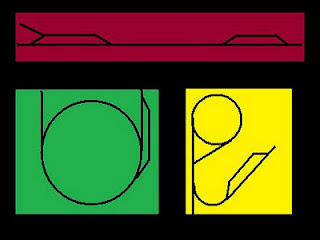Okay, I haven't explained The Micro Layout extensively for a while so I am re-posting an older article, rewritten.
What is a micro layout?
Micro layouts are a special classification of layouts that are of extremely small size. Depending on the gauge of the track used, a micro layout can be really small. For instance, a small standard gauge G scale layout can still be almost 32 square feet, but a narrow Gauge G scale such as Gn15 (G scale on HO scale track) a layout can be built in only 2 square feet.
History of micro layouts.
The idea of a small layout for a small space has been around since the dawn of the hobby. In the early days when manufacturer like Marx, American Flyer, and Lionel produced larger scaled trains, a small layout was really pretty big by today's standards. From the very beginning though, people have been looking for ways to make the most out of least space. After WWII, when HO scale had it's first runs, it became common to see layouts that went under a bed, or folded up into a counter or desk. Despite this, the most common way to start in the hobby was the 4X8 table. Those less than 4X8 were considered small layouts, those larger were considered medium layouts. Medium layouts were between the sheet of plywood and bedroom sized.
In the 60's, 70's, and 80's, the Micro layout took it's major leaps towards the micro we know today. The Gumstump and Snowshoe, the Timesaver, and Inglenook Sidings were three of the first to come onto the scene. All three were less than 8 square feet in the HO scale. It was during this time that HO scale also became the standard scale of the hobby, followed by O scale, standard gauge, and G scale. By the mid 90's, N scale had also come onto the scene, allowing layouts to be built even smaller. N scale during this time became the number two, behind HO scale in popularity.
In 2001-02, the Micro layout took it's latest shape. A man named Carl Arendt promoted a new scale, Gn15 (G scale trains running on HO scale track) which was able to handle extremely sharp curves. The Squarefoot Estate Railway (SFER) was one of the first to railroads to be built under a square foot. It was an instant hit. Although Carl Arendt has now passed away, his website, carendt.com is still around. It has arguably the largest collection of layouts under 32 square feet in size on the Internet. Here is the link:
carendt.com
The modern definition of a micro layout today, or "Arendtian micro layouts" is any layout that is under four square feet in size. Today, competitions, imagination, and the genius of previous designs fuel the latest trends in the minimal modeling hobby.
Types of micro layouts.
Micro layouts can be divided into three main categories: the pizza, the continuous, and the switching layout.
The pizza layout is a round or almost round layout that has few switches on it. It is used for displays and centerpieces. The continuous layout has more switches, and is most often designed for actually switching. The switching layout is a layout that does not go in a circuit, but rather has a maximum of switches for the space, and usually dense track. This type also follows the "phantom layout" design, where the train enters, then leaves the stage.
Of course, there is a large overlap in these categories, occasionally a circuit railroad designed specifically as a switching layout comes by, a pizza isn't always round, and the switching layout isn't always a matrix of track, challenging the operator to the fullest extent.
What scales are used in micro railroads?
Anyone who spends more than 5 minutes on a Google search about micro layouts sees that there is almost every scale imaginable that has been made to fit a micro layout design. Most commonly though, HO, N, OO, On30, and Gn15 designs are seen.
One thing that has helped micro layouts is the wildfire of new narrow gauge equipment. Narrow gauge has traditionally been used for tight spaces and for small scale operations. Micro layouts are a natural fit to those kinds of prototypes. There for HOn3, On30, OO7, OO9, O18, On30, On3, and Gn15 have grown very popular in today's world of Micro Layouts. Of all the layouts on carendt.com/ over half of them feature narrow gauge trains.
However, standard gauge still has it's place. In the micro layout world. Although narrow gauge is cool and popular, in today's prototype world, narrow gauge is seldom used, at least in the U.S. Standard gauge provides many prototype oppritunities for modelers. Hence, there is a relentless effort to make prototype standard gauge fit where ever it can.
Where can I find out more?
There are many places to find out more about micro layouts, and so I present a list of good links to follow:
carendt.com Carl Arendt's world renown website is full of thousands of examples of layouts less than 24 square feet.
gn15.info this sight provides plenty of examples of the unique Gn15 scale. There is also a forum which is helpful to finding out even more information about Gn15 railroads.
wymann.info/ShuntingPuzzles This sight focuses of switching puzzles. Great for those interested in a challenge.
freerails.com This link takes the reader to a very helpful forum which centers around micro modeling. However, a variety of scales and interests about model railroading can be found here.






No comments:
Post a Comment